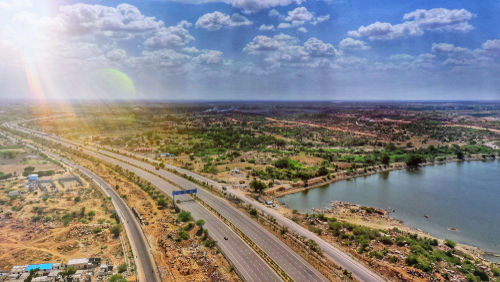Bangalore, known as a technology hub and one of the most populated cities in India, continuously attracts people from the peripheries to its development opportunities and quality of life. However, weak infrastructure has been a major drawback leading to traffic jams and traffic jams in many places. To solve these problems and smooth traffic, the Bangalore Development Authority (BDA) has proposed the Bangalore peripheral ring road bangalore, a major project to improve the residential infrastructure of the city.
The Bangalore Peripheral Ring Road is an ambitious 73-kilometre project spanning over 2,400 acres. It will be an 8-lane road with four service lanes, surrounding suburban areas of the city, including Anekal, East, and North Bangalore. The road will connect the NICE Interchange on Tumkur Road, cross Bellary Road and Old Madras Road, and terminate at NH 44 on Hosur Road.
The project will probably cost around Rs. 21,091 crores. It is expected to be completed by December 2027 as a public-private partnership, Construction, Finance, Design, and Model Operating (PPP- DBFOT) with BDA as the owner. Toll stations will be introduced along the route to recover costs, and two clover-leaf interchanges will be constructed at Airport Road and Old Madras Road.
The Bangalore Ring Road aims to ease traffic pressure on existing streets, benefiting policymakers and property developers. The city already has two ring roads, the inner ring road connecting Koramangala with Indiranagar and the outer ring road connecting all highways centred in Bangalore. However, the new ring road will help reduce traffic congestion and reduce the load on the existing inner and outer rings, ensuring smoother traffic.
The project faced several challenges and delays in the planning and implementation phases. Land acquisition issues, environmental concerns, and court hearings contributed to the delay. However, after receiving the necessary permits, the project will continue with the original length of 73 km. There are plans to develop a major residential and commercial centre in the city.
The PRR will have special features, such as provision for trams and heliports, eight lanes with four lanes on each side, and six service lanes. It will also include green spaces to compensate for the environmental loss and a radial distance of about 17-25 km from central Bangalore, acting as a bypass between the national highway and the national road.
The Bangalore Ring Road has been settled for long-term land acquisition and has achieved environmental clearances. The Karnataka state government funded the project through a PPP model, and all construction aspects received a green signal. In summary, the peripheral ring road bangalore is expected to open up new routes and opportunities for residents by improving connectivity, reducing traffic congestion, and promoting real estate development in the city. With a target completion date of 2027, this ambitious project promises to change the traffic landscape of Bangalore.



